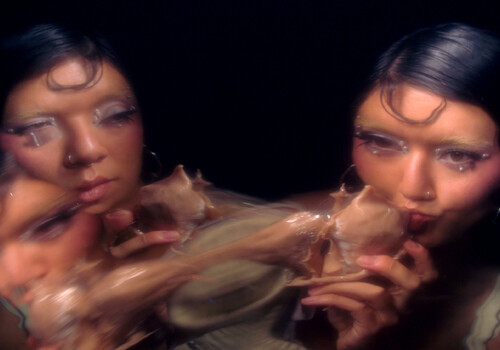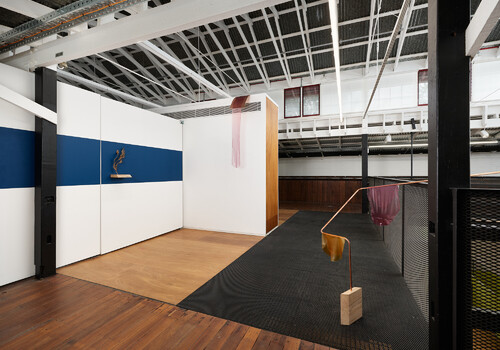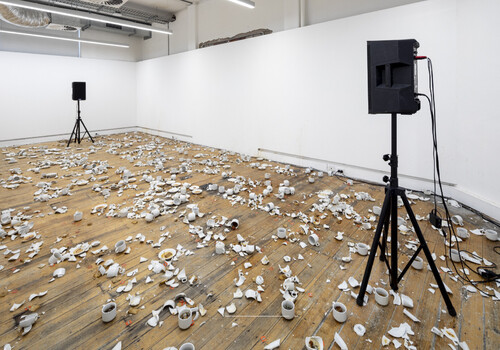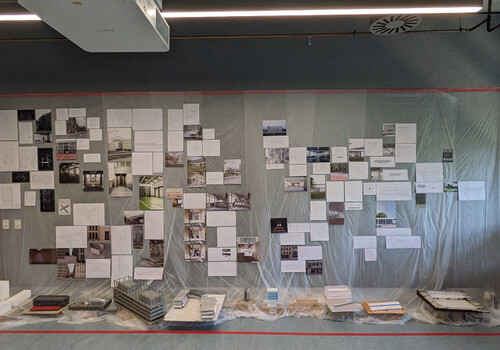Bachelor of Fine Art, Monash Art, Design and Architecture
By Leah Edwards
In a year that has seen relentless discourse and interference surrounding the bodily autonomy of women, Tia Keam and Scarlet Lili Thomas take striking ownership of the yonic. Thomas’s mixed media installation In Her Skin, In Her Space (2024) is found in one of the large gallery rooms on the second floor at Monash, tucked up against a door leading to the adjoining hallway. A little further along the same hallway, you can find Keam’s Purss Project (2024) hung on the wall, outside the main gallery spaces.
In a room filled with other artists’ overt references to flesh, Thomas’s wet red fruits read immediately as menstrual. Blood is a repeated motif in feminist art that is often used to reflect upon gendered violence. In her mixed media installation, Thomas layers further intricacy onto the motif as something that is also personal, intimate, and fruitful.

Scarlet Lili Thomas, In Her Skin, In Her Space, 2024, Mixed media installation: photographic assemblages with acrylic-painted lemon stamps on walls, 240 x 500 cm. Photo: Andrew Curtis.
The materials and textures seen in Thomas’s first photographic assemblage contains an analogised vaginal ecosystem, from the colours and textures of raspberries to the yeast of bread. Thomas has presented the visitor with these approachable placeholders in order to reclaim ownership and love for the female body and its functions amidst a global increase in misogynistic rhetoric and major regressions in women’s rights.

Scarlet Lili Thomas, In Her Skin, In Her Space, 2024, Mixed media installation: photographic assemblages with acrylic-painted lemon stamps on walls, 240 x 500 cm. Photo: Andrew Curtis.
The following photographic assemblage by Thomas shows the female form itself and re-establishes the unique personal relationship between a person and their own body. Thomas here again retains autonomy through familiarity with the minutiae of the body, such as scars, veins, wounds, a nipple, and once again returning to the fruit motif, the menstrual-like juice of a crushed raspberry. As suggested by the work’s title, In Her Skin, In Her Space, Thomas connects the autonomy of the body with the autonomy of women. Depictions of bodily autonomy and feminist body politics have remained a core defence against political and physical attacks on women’s bodies.

Tia Keam, Installation view of Purss Project: Fanny, Lily, Bussy, 2024, Assemblage of sock, purse, plether, and lingerie. Photo: Andrew Curtis.
Similarly, Tia Keam’s Purss Project displays a series of yonic shaped arrangements of lingerie and purses at various sizes and shapes with each given a personifying name. The delicate drapery of rich fabrics not only allows for a rare aesthetic appreciation of the yonic, but the uniqueness of each arrangement portrays a palpable sense of inclusivity and personality. It’s a suitable contemporary and feminist equivalent to Mapplethorpe’s famous flowers.
In a manner similar to Thomas’s 9x9 photographic arrangement, Keam utilises intimate personal familiarity with the body to demonstrate bodily autonomy. The nature of the clothing items and accessories used to create each arrangement, as well as the title of the project, suggests a closer focus on sexual autonomy as well.
As a woman writing about art by fellow women during an international decline in women’s bodily autonomy and a rise in misogynist rhetoric, I am reassured by the beauty, individuality, and ownership that both Tia Keam and Scarlet Lili Thomas have been able to find in the yonic.
Leah Edwards is a Naarm based artist and curator currently completing her Master of Art Curatorship at the University of Melbourne.









































